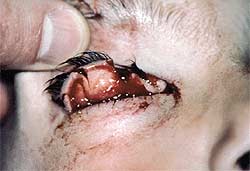Timely, copious wound irrigation crucial with animal injuries
About 4 million Americans are bitten by animals each year. Bites account for about 1% of all emergency room visits and cost more than $30 million annually. The true incidence may never be known, because many bite wounds seem too trivial to warrant medical attention.
The most common victims of animal attacks are children and young adults. Young children, especially boys, are the most likely to be bitten by dogs. Cat bites occur more often in women. Animals usually bite the hand or arm. Children are more likely to be bitten on the neck and head, especially the “central target area” comprising the lips, cheek, nose and periorbital region. Facial lacerations associated with dog bites are disproportionately severe when compared with lacerations from other sources.
The majority of reported domestic animal bites occur by animals that are known by their victims. Usually it is the victim’s pet or the pet of someone he or she knows. Many bites are provoked by the victim either knowingly or unwittingly. This is especially true with children, whose unpredictable behavior may provoke the animal. Provocative behaviors include approaching, disturbing, petting, feeding or even kissing the animal.
Get the details
When assessing a victim of an animal bite it is critical to include details about the offending animal, its background, the exact time of injury and whether it was a provoked or nonprovoked attack. Any animal that was acting oddly or being excessively aggressive may have been exposed to rabies. The animal should be isolated, and the local animal-control officer should be notified when applicable. Other critical information includes:
- Is the animal domestic or wild?
- What is the rabies vaccination status of the animal?
- What is the victim’s tetanus immunization status?
- Does the victim have any allergies?
- Is he or she immunocompromised or does he or she have any chronic diseases?
If the patient is immunocompromised, he or she may be at a greater risk of developing a serious infection from the injury.
Ophthalmic exam
Examination includes the standard ophthalmic testing with classification of the type of bite injury. Animal bites can be categorized as avulsions (loss of tissue), lacerations, puncture wounds or crush injuries. Most patients suffer a combination of insults.
Always evaluate the lacrimal canalicular system closely, because injury to this area is commonly associated with bites to the periorbital area. Diagram or photograph the injuries, because these will be of benefit in cases with irregular wounds or signs of infection and in cases that may involve litigation.
Bacterial cultures are usually unnecessary in uninfected bites. Samples for bacterial cultures (aerobic and anaerobic) should be obtained from any infected bite wound or those inflicted by an animal other than a dog or cat. X-rays are necessary if it appears that there may be a fracture or when a foreign body, such as the animal’s tooth, is present.
Irrigation, débridement
|
|
The most important therapeutic step is timely and copious wound irrigation with normal saline using an 18-ga to 20-ga needle or plastic catheter on a 20-mL syringe. A minimum of 100 cc of fluid should be used to irrigate the involved tissue, but be careful not to inflict additional trauma or to inject fluid into the surrounding tissues.
Necrotic and devitalized tissue may be débrided, and any foreign material removed. Care should be taken not to remove so much tissue as to cause problems with wound closure and appearance. Reirrigation following débridement reduces contamination.
Facial and eyelid wounds, except for puncture wounds, should be repaired by standard wound closure technique. Canalicular lacerations can be repaired in a multilayered fashion with the use of silicone intubation. The tubing is removed in 5 or 6 months. Wounds around the face heal well if not infected. This is because of the excellent blood supply in the area and because the head is not a dependent part of the body, resulting in little edema.
Infection at the wound site can result from contamination from the oral flora of the animal, the patient’s own normal skin flora or the environment. Fewer than 20% of dog bites become infected, but infections have been reported with 28% to 80% of cat bites. Most infected dog and cat bite wounds yield mixed polymicrobial organisms. Pasteurella multocida and Staphylococcus aureus are the most common aerobic organisms, but anaerobic organisms can also be found.
Treatment
Infected wounds should be treated with amoxicillin-clavulanate potassium in oral dosages of 500 mg every 8 hours for adults, or 40 mg/kg/day in divided doses every 8 hours for children up to 40 kg of weight. Treatment for cellulitis continues for 10 to 14 days. Prophylactic antibiotic treatment of periorbital animal bites should be taken for 3 to 7 days unless the risk of infection is low or the wound is superficial. Adults who are allergic to penicillin can be treated with doxycycline. Other medications for use in both adults and children include azithromycin, cefuroxime, clarithromycin and trimethoprim/sulfamethoxazole.
Prophylaxis against tetanus is indicated if the patient has had fewer than three doses of tetanus toxoid, if it has been more than 5 years since the patient’s last dose or if the patient’s active immunization status is not known.
Rabies
The most dangerous animal bite complication is infection with rabies, an acute encephalomyelitis that is always fatal. Fortunately, fewer than 20% of untreated people have a chance of contracting rabies from the bite of a rabid animal. The most common sources of rabies in the United States are wild animals such as raccoons, skunks and bats.
There are presently four formulations of three inactivated rabies vaccines available in the United States. If rabies is suspected in the attacking animal, immunization of the victim should begin within 48 hours of the bite.

